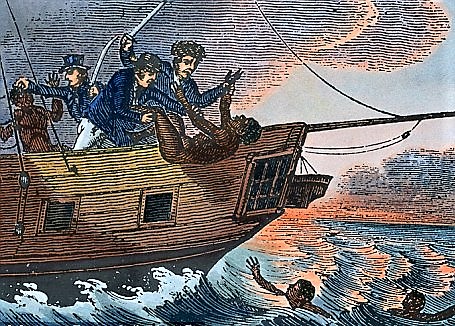Class and Race in the Royal Family: “Dido” Elizabeth Belle and the Lady Elizabeth Murray
by Kathy Grear 05/21/2018
Dido Elizabeth Belle and the Lady Elizabeth Murray “Dido” Elizabeth Belle was a bi-racial woman born into slavery in 1761 in the West Indies, the daughter of a slave woman, Maria Belle
“Dido” Elizabeth Belle was a bi-racial woman born into slavery in 1761 in the West Indies, the daughter of a slave woman, Maria Belle and a British career naval officer, John Lindsay, who was stationed there.
While the details of their relationship are unknown, Lindsay was transferred back to Britain in 1765 and took the child with him. Lindsay would later in his career be knighted and would reach the rank of Admiral in the British Royal Navy.
She escaped a life of slavery
Lindsay entrusted the young girl to his uncle William Murray and his wife Elizabeth, where she escaped a life of slavery for, you see, William Murray was the First Earl of Mansfield.
The Murrays educated Belle, bringing her up as a free gentlewoman at their Kenwood House, together with their niece, Lady Elizabeth Murray, whose mother had died. Even as an illegitimate child, she was afforded the privileged life that came with her father’s bloodline. But because she was also biracial/black, she was denied full societal and familial acceptance.

“Belle lived at Kenwood House for 30 years. Her position was unusual because she was born into slavery according to colonial law. Lord and Lady Mansfield to some extent treated her and brought her up as a member of the Murray family. As she grew older, she often assisted Mansfield by taking dictation of his letters, which showed she had been educated.”
The social conventions of his household are unclear. A 2007 exhibit at Kenwood suggests that she was treated as “a loved but poor relation.” Other aspects of Belle’s life, such as being given expensive medical treatments and luxurious bedroom furnishings, were evidence of her position as Lady Elizabeth’s equal at Kenwood.
Dido Belle’s affect on the abolition of slavery in England
There is a great amount of speculation on Dido Belle’s affect on the abolition of slavery in England. Why you ask?
Because William Murray, 1st Earl of Mansfield was also Lord High Chief Justice of England. He would rule on two cases involving the trans-Atlantic slave trade which would change the nation.
The Zong Massacre was at the heart of Gregson vs. Gilbert. The Zong slave ship was headed from West Africa to Jamaica in 1781 when the captain and crew threw 133 slaves overboard to their deaths, a practice not uncommon during the slave trade. The owners of the Zong later said that because of illness and a shortage of fresh water, it was necessary to dump “cargo” to save those remaining on the ship. English law at the time allowed the ship’s owners to file an insurance claim if they threw slaves overboard to save the ship, but not if the slaves died of natural causes.
The Zong’s owners filed a claim, but the insurers refused to pay after it came to light that the ship probably wasn’t short on water. Lord Mansfield thought it obvious that the slaves were thrown overboard in order to file an insurance claim for human “cargo.”.
In court, Lord Mansfield ruled in favor of the insurers, but he stopped short of saying murder had been committed. Still, the Zong case brought to light the horrors of the slave trade for the British public and spurred the movement to end it.
 Murray also presided over the earlier landmark Somerset case in which the legality of slavery in Britain was questioned. James Somerset was a slave brought from Boston to England, where he escaped. He then challenged his master for his freedom on the basis of English common law. In his decision, Mansfield made his view on slavery perfectly clear.
Murray also presided over the earlier landmark Somerset case in which the legality of slavery in Britain was questioned. James Somerset was a slave brought from Boston to England, where he escaped. He then challenged his master for his freedom on the basis of English common law. In his decision, Mansfield made his view on slavery perfectly clear.
He ruled that there was no basis in English common law for slavery and that it was so “odious” that only a specific law creating slavery could make it legal in Britain, therefore “the black must be discharged”. Somerset was freed.
Though Mansfield could have gone further in his decisions, both laid legal groundwork for the abolitionist movement and eventually led to the slave trade being outlawed in Britain in 1807 and slavery being abolished in the British Empire in 1833.
Did his relationship with his niece Dido affect his feeling and later rulings on slavery? Historians think so. “Dido Elizabeth Belle must have had an impact on Lord Mansfield’s thinking. He didn’t have children of his own and had afforded Belle what was an unheard-of degree of privilege and status for an illegitimate black child at the time.”
In his will written in 1783, Lord Mansfield officially confirmed Belle’s freedom; to secure her future he also bequeathed her with £500 as an outright sum and a £100 annuity, which she received after his death in 1793.
Dido Belle married John Davinier, a Frenchman who worked as a gentleman’s steward, on December 5, 1793 They had three sons. One of their sons, Charles served as an officer in India with the 30th Native Infantry.
Belle died in July 1804 at the age of 43. Belle’s last known descendant, her great-great-grandson Harold Davinier, died childless in South Africa in 1975.




No Comments so far
Jump into a conversationNo Comments Yet!
You can be the one to start a conversation.Only registered users can comment.